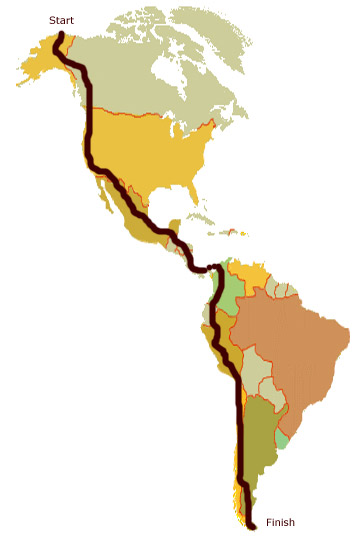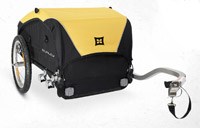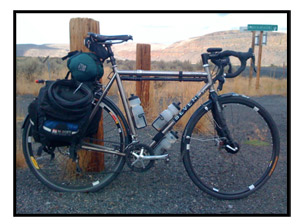Cycling Tip-to-Tip through the Americas - Plans for the Future
In the summer of 2012, Untamed Science will begin it’s tip-to-tip America campaign to promote an understanding of our human footprint and the biodiversity we’re impacting. We’re tracing the footprints of human migration as we ride our bikes from the tip of North America to the tip of South America. Along the way they will observe cultures, wild places, and cities to understand our relationships to nature. What are the issues? Are we really in as much trouble as we might be lead to believe? Are we in more trouble?
The Route
The journey will begin in Prudhoe bay, near the Arctic National Wildlife Refuge, travel south through the Yukon, Britsh Columbia and then down through Washington, Oregon and California. From there, the team will ride east into Arizona, and then south through the highlands of Mexico. North of Mexico city, the team will head east to Veracruz, across Belieze and Honduras, Nicagua, Costa Rica, and Panama. The team will take a boat around the Darien Gap and ride through Columbia to the Ecuadorian Amazon. Finally, the team will ride through Peru and south through Chile and Argentina.
Key stops along the way
- Arctic National Wildlife Refuge, Alaska
- Cassiar Highway, BC
- Sequoia National Park, CA
- Death Valley, California
- The Grand Canyon, Arizona
- Pico de Orizaba, Mexico
- Reefs off of Belieze and Roatan, Honduras
- Lake Nicaragua
- Corcovado, Costa Rica
- Barro Colorado Island, Panama Canal
- Columbian Highlands
- Yasuni Biodiversity Reserve, Ecuador
- Atacamba Desert, Chile
- Feudalafu River, Chile
- Tierra del Feugo, Argentina
The Riders
- Jonas Stenstrom
- Rob Nelson
- Louise Fornander
- Haley Nelson
Support Vehicle
So that Rob and Haley can bring their newborn with them on this journey, a support vehicle will leap-frog ahead of the team. Besides, allowing the Nelson family to stay together, the support vehicle will serve as a remote upload station to add video podcasts along the way.
Possible vehicles:
Possible Funding sources (crew brainstorming before LIVE)
- Get vehicle funded
- Dried food funded – sent to stops along the way.
- Environmental Science videos pay for way: Produce weekly video topics along the way, for air on news stations / on the internet, etc.
- Ads on the website.
- Sponsorships – DiveRite (already secured), Bike company, camera company, REI?,
Incorporating Environmental Science Series
1.An Introduction to Environmental Science and the Footprints Trip
2. Economics and Environmental Policy(Environmental Economics and Environmental Policy)
– Salmon farming – Meet up with Twyla in BC.
3. Earth’s Environmental Systems(Matter and Environment – Earth Spheres – Water cycle – Carbon cycle – Nitrogen Cycle – Phosphorus cycle)
– Use Earth Spheres video (Done)
4.Population Ecology(Habitats – Population density – population size/growth)
Animal Populations
– Orcas/sea otters/sea urchin relationship (meet up with Twyla in BC).
5.Evolution and Community Ecology (Niche, competition, predation, parasitism, herbivory, mutualism, commensalism, Food webs, Succession, Invasive species)
Invasive species
– Find an invasive species from the places we’re going. It could be anything.
Evolution
– Examine unique South American Animals (or use Galapagos as an example if we can get funding to go over there).
Competition
– Re-enactment of Paine’s Sea star experiment in Washington.
6. Biomes and Aquatic Ecosystems
World Biomes / Terrestrial and Aquatic
– Use existing videos (add chaparrel, deciduous forest, tundra, ice caps, desert, desert scrub)
7. Biodiversity and Conservation (Definitions, Causes for biodiversity loss, biodiversity hotspots, cloning, captive breeding, corridors)
Biodiversity
– Shoot video on the lose of biodiversity in Yasuni (Ecuador)
– Keep already ‘produced video on Biodiversity’ (shot in Panama 2007)
8. Human Population (Growth, density, distribution, impacts based on demographics … )
Human populations
– Look at what is happening to Mexico City – high growth rate???
9. Environmental Health (Toxicology, infectious disease, natural disasters, biomagnification, chemical hazards,
Biomagnification
– Look at how DDT is still being used in farms in Mexico.
10. Urbanization(Land Use, Environmental impacts, Urban sprawl, Green Building, Sustainable City planning, Mass Transit)
Green Building Technology
– Green building/Green architecture – Team up with Green Building Foundation.
11. Forestry and Resource Management(Renewable resources, Deforestation, Timber harvesting, Forest Management)
Deforestation
– Look at clear cutting in the Amazon rainforest. What is happening here? Team up with some sort of ecological foundation for this one.
12. Soil and Agriculture (types of soil, soil erosion, soil pollution, desertification, pesticies, green revolution, GM crops, sustainable agriculture, organic farming)
What really is genetically modified foods?
– Wheat in Mexico – didn’t responde well to fertilizers, got too tall and blew over and died. Now produced a shorter wheat that doesn’t blow over…
Soil Erosion
– Hiking up Pico de Orizaba in Mexico to look at the soil erosion that was happening on that mountain.
Where does your food come from?
– Looking at Banana production in Costa Rica. Or Coffee Production in Columbia.
13. Mineral Resources and Mining(rock cycle, mining basics, impacts of mining, mining laws and regulation)
Where do the metals around you come from?
– Trace back the metals to their origin
14. Water Resources(groundwater use, water pollution, watersheds, agricultural uses, freshwater solutions, water treatment) – Could Highlight Jiame’s water video in Africa
Freshwater resources
– Visit the Southwest where they are undergoing extreme water shortages.
15. The Atmosphere (atmosphere basics, layers of the atmosphere, atmosphere pollution, smog, acid rain, ozone holes, clean air act)
Atmospheric Basics
– Skydiving in Elisnore, CA: General Atmosphere topics
16. Global Climate Change(Greenhouse effect, sunspot cycles, wind patters, ocean circulation, volcanic influence, global warming, effects of climate change, Kyoto protocol, human response to climate change, carbon offsets)
Climate Change
– Looking at Glaciers melting in Alaska.
17. Nonrenewable Energy (Forms of Energy, Fossil fuels, Coal, Oil, Gas, Nuclear power)
Fossil fuels and how we pull them out of the ground.
– Visit the Arctic National Wildlife Refuge: look at the issues
18. Renewable Energy Alternatives(Geothermal Energy, Hydro-power, Solar, Hydrogen Fuel, Wind Energy)
Hydro-power
– Visit the hydro-power dams in Chile to look at the issues.
19. Waste Management (Landfills, incineration, recycling, composting, hazardous waste, radioactive waste,
Landfills
– Examine how waste is managed in the different countries.





































































































